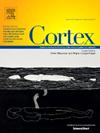Visibility manipulations affect the functional connectivity related to illusory body ownership
IF 3.3
2区 心理学
Q1 BEHAVIORAL SCIENCES
引用次数: 0
Abstract
The rubber hand illusion is a multisensory phenomenon where congruent visual and tactile stimulation induces ownership over a visible dummy hand. Manipulating visual inputs during the RHI experimental procedure may affect the strength of the illusion and alter the activation of relevant brain regions. This suggests that visual input modifications could influence the normal interconnectivity among brain regions. To test this hypothesis, we used functional magnetic resonance imaging (fMRI) data from 45 neurotypical adults to assess how functional connectivity (FC) was influenced by changes in the visibility of a virtual hand during the visuo-tactile stimulation related to a virtual hand illusion (VHI). The visibility manipulations concerned only the virtual hand, not the entire visual scene, and were accomplished through video editing. Tactile stimulation was administered by an MRI-compatible robot capable of delivering precise, repeatable stroking patterns on the participant’s hand. Visibility and visuo-tactile congruence modulated FC between occipital, sensorimotor, and default mode regions. FC between these regions also modulated with the time phase of VHI induction. These findings suggest that reducing visibility of the virtual hand shifted the balance between vision and touch in the mental representation of the body, especially in later stages of visuo-tactile stimulation. Revealing that altered hand visibility dynamically modulates the FC related to multisensory integration during the VHI, our study underscores the critical role of visual input in shaping body representation.
可见性操作影响与虚幻身体所有权相关的功能连接
橡胶手错觉是一种多感官现象,在这种现象中,一致的视觉和触觉刺激诱导了对可见假手的所有权。在RHI实验过程中操纵视觉输入可能会影响幻觉的强度并改变相关大脑区域的激活。这表明视觉输入的改变可能会影响大脑区域之间的正常互联性。为了验证这一假设,我们使用了来自45名神经正常成年人的功能磁共振成像(fMRI)数据来评估在与虚拟手错觉(VHI)相关的视触觉刺激过程中,虚拟手的可见性变化对功能连通性(FC)的影响。可见性操作只涉及虚拟手,而不是整个视觉场景,并通过视频编辑完成。触觉刺激由一个核磁共振兼容的机器人进行,该机器人能够在参与者的手上提供精确的、可重复的抚摸模式。可见性和视触觉一致性调节枕部、感觉运动和默认模式区域之间的FC。这些区域之间的FC也随VHI感应的时间相位而调制。这些发现表明,虚拟手的可见度降低改变了身体心理表征中视觉和触觉之间的平衡,尤其是在视觉-触觉刺激的后期阶段。我们的研究揭示了手部可见性的改变动态调节了VHI过程中与多感觉整合相关的FC,强调了视觉输入在塑造身体表征中的关键作用。
本文章由计算机程序翻译,如有差异,请以英文原文为准。
求助全文
约1分钟内获得全文
求助全文
来源期刊

Cortex
医学-行为科学
CiteScore
7.00
自引率
5.60%
发文量
250
审稿时长
74 days
期刊介绍:
CORTEX is an international journal devoted to the study of cognition and of the relationship between the nervous system and mental processes, particularly as these are reflected in the behaviour of patients with acquired brain lesions, normal volunteers, children with typical and atypical development, and in the activation of brain regions and systems as recorded by functional neuroimaging techniques. It was founded in 1964 by Ennio De Renzi.
 求助内容:
求助内容: 应助结果提醒方式:
应助结果提醒方式:


